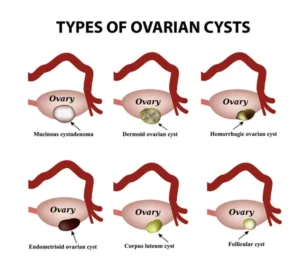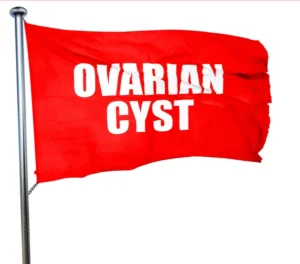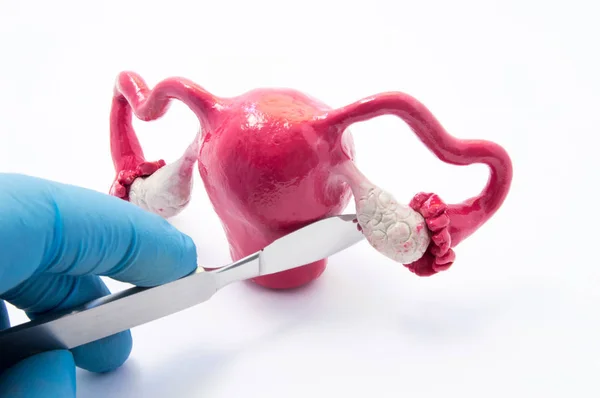Ovarian cysts are a prevalent health issue affecting a wide range of women across different age groups. An ovarian cyst is essentially a fluid-filled sac that develops on or inside an ovary. While many ovarian cysts are harmless and resolve on their own, understanding what size of ovarian cyst is dangerous is crucial for effective management and treatment.
Table of Contents
ToggleTypes of Ovarian Cysts

Ovarian cysts vary in type and origin, each presenting different risks and implications for health. Here are the most common types discussed across the sources:
- Functional Cysts: The most prevalent, these form during the menstrual cycle and typically resolve without treatment.
- Follicular Cysts: Develop when the follicle doesn’t release an egg.
- Corpus Luteum Cysts: Form if the follicle seals itself after releasing an egg and accumulates fluid.
- Pathological Cysts: These arise not from the normal function of the menstrual cycle and may require closer monitoring or intervention.
- Dermoid Cysts (Teratomas): Composed of various tissues like hair, skin, or teeth.
- Cystadenomas: Develop on the ovarian surface and can be filled with mucous or a watery fluid.
- Endometriomas: Often linked to endometriosis, containing endometrial tissue that can cause pain and affect fertility.
- Polycystic Ovary Syndrome (PCOS): Characterized by numerous small cysts on the ovaries due to hormonal imbalances.
This emphasizes the importance of identifying which size of ovarian cyst is dangerous, based on the type and associated symptoms
When to Consider Surgery: What Size of Ovarian Cyst is Dangerous?

The decision to operate on an ovarian cyst largely depends on its size, symptoms, and potential for complications. Here’s a guideline on what size of ovarian cyst is dangerous and typically necessitates surgical intervention:
- Size Threshold for Surgery: Generally, cysts larger than 5 cm are closely monitored and often considered for removal, especially if they do not resolve or decrease in size over subsequent menstrual cycles.
- Symptoms Indicating Surgery:
- Persistent pain or discomfort in the pelvis.
- Bloating or swelling in the abdomen.
- Symptoms of pressure on other organs, such as frequent urination or difficulty emptying the bladder completely.
- Risk Factors for Surgery:
- Rapid Growth: A cyst that increases quickly in size may suggest malignancy.
- Solid Components: Cysts that appear complex, with both fluid and solid components, can increase the risk of cancer.
- Postmenopausal Women: Cysts in postmenopausal women have a higher risk of being cancerous.
The question what size of ovarian cyst is dangerous? isn’t solely about dimensions but also about the cyst’s behavior and associated symptoms.
Symptoms of Ovarian Cysts
While many ovarian cysts remain asymptomatic and harmless, certain symptoms can signal a need for medical evaluation. Understanding what size of ovarian cyst is dangerous involves recognizing these symptoms that might indicate larger or problematic cysts:
- Common Symptoms:
- Sharp or dull pain on the side of the cyst in the lower abdomen.
- Fullness or heaviness in the abdomen.
- Bloating or swelling in the abdominal area.
- More Severe Symptoms Indicating Larger or Ruptured Cysts:
- Sudden, severe abdominal pain.
- Fever, nausea, or vomiting.
- Rapid breathing or signs of shock (in cases of rupture).
- Symptoms Requiring Immediate Medical Attention:
- Pain accompanied by vomiting or fever.
- Sudden, sharp abdominal pain.
- Signs of a ruptured cyst, such as intense abdominal pain and dizziness.
Each symptom’s intensity and presence can help determine what size of ovarian cyst is dangerous and whether it might require more aggressive treatment or monitoring.
Treatment Options
Treatment for ovarian cysts can vary widely depending on the cyst’s type, size, and symptoms. Knowing what size of ovarian cyst is dangerous helps in determining the appropriate intervention:
- Watchful Waiting:
- Small, non-symptomatic cysts are often monitored over several menstrual cycles.
- Regular ultrasound exams to check for changes in size or appearance.
- Medication:
- Hormonal contraceptives may be prescribed to prevent the formation of new cysts, especially in cases of recurrent functional cysts.
- It could be advised to take painkillers to control symptoms.
- Surgical Intervention:
- Laparoscopy: Used for smaller cysts. It’s minimally invasive, involving small incisions and the use of a camera to guide the surgery.
- Laparotomy: Required for larger cysts or when cancer is suspected. This procedure involves a larger abdominal incision.
- Post-Surgical Considerations:
- Monitoring for any changes in the remaining ovarian tissue.
- Continued follow-ups to ensure no new cysts develop and hormone levels remain stable.
Each treatment modality is chosen based on a careful evaluation of what size of ovarian cyst is dangerous, the symptoms presented, and the overall health profile of the patient.
Impact on Fertility and Considerations for Surgery

The potential impact of ovarian cysts on fertility and the considerations for surgery are critical, especially for women of reproductive age. Understanding what size of ovarian cyst is dangerous can guide decisions that balance immediate health needs with future fertility aspirations:
- Fertility Impact:
- Most ovarian cyst surgeries are conservative, aiming to preserve as much ovarian tissue as possible.
- The type of cyst and the extent of the surgery can affect ovarian reserve and future fertility.
- Surgical Considerations:
- Preservation of Ovarian Function: Surgeons strive to remove cysts while keeping the ovaries intact.
- Minimally Invasive Techniques: Preferred for less impact on fertility, such as laparoscopy.
- Factors Influencing Surgery Decisions:
- Age and Reproductive Plans: Younger patients with future pregnancy plans might opt for more conservative treatment options.
- Size and Symptoms: Larger cysts causing symptoms may require more aggressive surgical approaches, potentially affecting reproductive organs.
- Post-Surgical Recovery:
- Monitoring hormone levels and ovarian function post-surgery is crucial.
- Future pregnancy planning may involve assisted reproductive technologies if natural conception is challenging.
Understanding what size of ovarian cyst is dangerous helps tailor treatment plans that consider both the immediate removal of harmful cysts and the long-term reproductive health of the patient.
Preventive Measures and Regular Monitoring
Preventive strategies and regular monitoring are key components in managing ovarian cysts effectively, especially in understanding what size of ovarian cyst is dangerous. Here’s how ongoing vigilance can play a critical role:
- Lifestyle and Dietary Adjustments:
- Maintain a healthy diet and weight to help regulate hormonal balance.
- Regular physical activity to improve overall reproductive health.
- Regular Gynecological Exams:
- Annual check-ups to detect any changes or developments early.
- Routine ultrasounds for those with a history of ovarian cysts or PCOS.
- Hormonal Management:
- Use of hormonal contraceptives to potentially reduce the formation of new cysts.
- Hormone therapy might be considered to manage symptoms related to PCOS.
- Education and Awareness:
- Understanding the signs and symptoms of problematic cysts.
- Being informed about what size of ovarian cyst is dangerous aids in early intervention.
- Monitoring High-Risk Individuals:
- Closer surveillance for women with a family history of ovarian cancer or those diagnosed with endometriosis.
Regular monitoring and preventive care are crucial in managing the risks associated with ovarian cysts and ensuring the long-term health of reproductive organs.
READ ALSO:
-
8 Incredible Chia Seeds Benefits for Skin: Why Your Dermatologist Might Recommend Them
-
5 Proven Benefits: How Vitamin B6 and Unisom Ease Morning Sickness Safely
-
Innovative claim of physiotherapy in Medicare: All You Need to Know
-
Acetaminophen Codeine: Comprehensive Guide to Effective Pain Management
